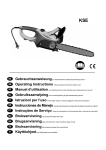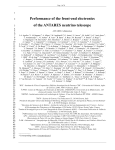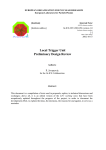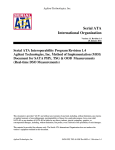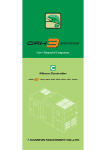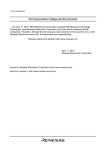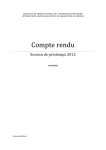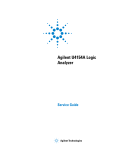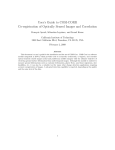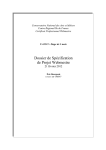Download A real time electronics emulator with realistic data generation for
Transcript
A real time electronics emulator with realistic data generation for reception tests of the CMS ECAL front-end boards T. Romanteau Ph. Busson, C. Collard, A. Debraine, D. Decotigny, L. Dobrzynski, A. Karar, N. Regnault 1 Laboratoire Leprince Ringuet, 91128 Palaiseau, France [email protected] Abstract The CMS [1] electromagnetic calorimeter (ECAL) [2] uses 3 132 Front-End boards (FE) performing both trigger and data readout functions. Prior to their integration at CERN, the FE boards have to be validated by dedicated test bench systems. The final one, called “XFEST” (eXtended Front-End System Test) and for which the present developments have been performed, is located at Laboratoire Leprince-Ringuet. In this contribution, a solution is described to efficiently test a large set of complex electronics boards characterized by a large number of input ports and a high throughput data rate. To perform it, an algorithm to simulate the Very Front End signals has been emulated. The project firmwares use VHDL embedded into XILINX Field Programmable Gate Array circuits (FPGA). This contribution describes the solutions developed in order to create a realistic digital input patterns real-time emulator working at 40 MHz. The implementation of a real time comparison of the FE output streams as well as the test bench will be also presented. I. INTRODUCTION The present XFEST project is part of the electronics boards validation system described in [3]. It has been designed and built to test up to 12 FE boards at the same time. The same digital input patterns, at a rate of 40 MHz, are sent onto all Front End (FE) boards. Each FE receives an equivalent of 25 channels 14 bits digital data streams at a 40 MHz clock frequency. The data are processed by dedicated Asics called FENIX [4]. In order to emulate the 25 digital input vectors, a prototype version of the FE board equipped with commercial programmable circuits in place of the FENIX Asics has been used. This board, called “EF”, is used in a reverse mode to its original usage as FE prototype. One EF is installed on a motherboard designed and developed at LLR. The main role of this motherboard is to insure the replication of the 25 digital signals in order to feed the FE boards. In an initial phase of the project, it has been foreseen to have three motherboards each one equipped with one EF in order to test at the same time 12 FE boards. In the current running, the system limits itself to one motherboard with four FE (Figure 1). 1 Present address: LPNHE Paris VI-VII (http://www-lpnhep.in2p3.fr/) Slow Control FEC interface LHC clock generation 25 data bus Token Ring bus Carte EFCarte EF EF board Carte FECarte FE FE board XFEST Test Platform 1 EF for stimuli + 4 EF in test FE board FE board FE board Trigger path TCC24 Optical Links to TCC Comparator Test Bench Control Data path Parameter setting / Command Figure 1: Display of the XFEST test bench The outputs of the FE boards under test are shipped to a prototype of the Trigger and Concentrator Card [5] (TCC24) by optical fibres. The TCC24 is equipped with commercial programmable circuits. In order to perform the real time comparison of the FE outputs, the TCC24 has to run with a dedicated firmware. To achieve the validation goals two different firmwares have been developed for the project as well as the interface to drive the setup: • • For the 25 signal emulators the following signal characteristics have been implemented: the analogue signal shape, its potential pileup, the electronics noises and pedestals, the trigger occurrence distribution and the signal amplitude which have been randomly generated. Amplitude, gains, signal range and level of noise are all adjustable via an integrated I2 C interface [6]. This dedicated firmware is loaded into the FPGA of the EF board. For the comparison system, the main issue is to aggregate and compare in a same clock domain all data from different clock time buckets. The real time computing of all input data is a key point to solve the buffer control problems. The dedicated comparison firmwares are loaded to the TCC24 FPGA’s. • Parameters setup, like the reference card selection, is possible through an embedded VME interface. Diagnostic and access to error counting are included in the design. The interface is described in [3]. The validation test for a set of FE, performed for about one hour (equivalent to 1013 different patterns), is obtained when all trigger and data outputs are identical during the testing time at the bits level. II. PATTERN GENERATION SOLUTION A. Overview Five Virtex2 FPGAs, from XILINX, present on the EF board are reprogrammed in a reverse mode to emulate the signals send by the VFE electronics. These FPGA devices, called ‘PATGEN’, work with an embedded firmware providing pattern generator data. A sixth FPGA device on the EF board is used to control and synchronise all the others by a start/stop software command. An I2 C interface is used for the internal parameters setting. To test more efficiently the discrimination capabilities of the FE board, it has been decided to favour a signal amplitude distribution with low level amplitudes rather than the high one. (7.6 hours) is low by using a high bit length number. The possibility to work within a pre-defined range of energy can also be set by defining minimum and maximum amplitude values accessible through internal registers. To achieve it, a new IEEE VHDL package [7] has been experimented. The digitally coded waveform of the signal is stored in a memory and can be modified by the user. Two memory outputs can be mixed to produce a realistic pileup shape. The automatic gain switching as well as the pedestal and the noise of the ECAL VFE electronics MGPA 3 Asics chip can also be emulated4 . This specific implementation is now in operation. All parameters of the ‘PATGEN’ devices can be set by the user via the embedded I2 C interface. The user can also access and control the registers providing the test status. The interface is controlled by a software application described in [3]. Figure 3 shows the block diagram of a single channel pattern generator. A pipelined architecture has been chosen to guaranty that it will run at the LHC clock frequency. Figure 3: Block diagram and resources of a single channel Pattern Generator device (PATGEN) B. Simulation phase Figure 2: Shape of the signal amplitude distribution (top) provided by the EF pattern generator. It is obtained by mixing (middle) several non-correlated LFSR (low) distribution. A single side triangle distribution, as shown of Figure 2 (top histogram) is used for the signal model. The algorithm also allows event pileup at a level of 10%. To obtain the signal distribution, a uniform pseudo random number generator2 has been synthesized in the FPGAs providing a flat distribution as shown on Figure 2 (bottom histogram). By mixing several non-correlated LSFR, one obtains a triangle distribution as shown on Figure 2 (middle histogram). The noise is also emulated with another LFSR whose repeatability sequence 2 Based on a Logical Shift Feedback Register (LFSR). Initialisation with a seed equal for which all bits are at ‘1’ or ’0’ is forebidden. To check by simulation the signal amplitude distribution, two methodologies have been developed. The first one uses Matlab/Simulink software, and is a very fast methodology, but the connection with the HDL model did not exist when our tests have been carried out. The second one uses a library of specific procedures developed in VHDL. It has been implemented in the test bench at the top level. The standard HDL simulator console then exhibits a pseudo graphic distribution curve. Several data files including the values produced with the HDL simulation have been produced and successfully imported within the ROOT [8] framework for analysis. Another important point has been to check the access to the internal registers. They are used to implement the stop/start commands and study the effect of the parameters change. Thanks to the re-use of an I2 C IP and the CERN simulation library, it has been possible to carry out these tests easily. Performing these tests in a HDL simulation 3 Multiple Grain Pre-Amplifier Electromagnetic Calorimeter readout chip for CMS 4 For each of the three available gains the user has a set of internal registers to define the value of gain, pedestal and noise. III. TRIGGER AND DATA PATH ANALYSIS environment allowed a fast development and a precise analysis on the generated data. A. Overview Figure 4: General and detailed implementation views of the “PATGEN“ FPGA. All kind of available resources are used. Since the whole design can be viewed as a data path system, a pipelined architecture has been used. The insertion of some pipeline registers along the path allowed reaching the working frequency. The total latency does not have a real importance here, but the system has to work at the nominal frequency. However this type of architecture increases the number of used registers in a significant way. The developed architecture gives access to a large set of internal resources available in the Virtex2 device (Block RAM, multiplier, tri-state buffer). It represents 860.000 equivalent gate count and a die occupancy ratio of 70 %. The developed design is a good candidate to perform, as an efficient testing platform of the FE boards. This project proves that complex signals provided by the Front End electronics of HEP experiments can be emulated within a dedicated and versatile digital electronics system. 5 Intellectual Proprietary electronic block, based on an assembly of logical primitives and provided by an outside source TCC24 1x I 2 C Interface TCCvi 5 x Pattern generators The main function of the XFEST test system is to provide the same signals to the FE boards plugged on the motherboard. Each of them sends, via two optical links, their output information to a TCC24 [5] prototype board. One link (Trigger Path) continuously transmits computed trigger vectors, the second one (Data Path) sends the internal buffered data, when a L1A event accept is sent to the FE via the Token Ring (Daisy chain bus used for inter-connexion of the FE board). The emulated signals are built out of 25 data buses arriving through 5 connectors soldered on each FE board. Each FE board synchronizes the data with the LHC clock distributed via the Token Ring port and delivered by a FEC [9] board. Due to the time delay between two FE boards, this clock is provided to each board with a time lag which has to be compensated. This is achieved for each FE with a dedicated hardware, called PLL [10]. All boards, respecting the setup data time, can not be necessarily synchronized within the same clock phase. Consequently, a different clock time domain is also created for each of them. The data buffer made out of headers, control words and real data is sent to the associated deserialisers of the TCC24. On the reception side, each of them will be retrieved from the serial data stream by a deserialiser component. The outputs of these components are connected to FPGA programmable devices. On their own path, the named functions ‘TRIGPATH’ and ‘DATAPATH’, embedded in these programmable devices will check that all received data for all channels are the same. TCCex All functionalities required for a five channels pattern generator have to fit the one million logical gates device available on the EF board. The system needs up to 41 multipliers and 53 adders, working in signed or unsigned arithmetic. As the targeted device does not embedded all requested dedicated multipliers a XLINX IP5 generator software library has been used to place some pipelined multipliers on the programmable matrix. To ease the placement and the routing, and respect the temporal requested performances, it has been necessary to manually define physical sectors on the matrix for each large subset of the design. This process called "floor-planning" can also clearly reduce the necessary time to place and route the cells. Figure 4 shows the affected physical areas for each of the 5 pattern generators sub blocs and for an I2 C interface functions. S BS Controle r C. Implementation VME Crate PC Driven CH1 JTAG bus 25data bus 12 Optical encapsulated Fibber Token Ring bus / LHC clock transport Optical fibber link AGILENT 81134 A Pulse /Pattern Generator - + EF board CH 2 - + XFEST Test Platform Trigger path XFESTclicforstart Fhxshgfdhh 1 2 3 3 4 4 4 rrtttyuu Gfhfhf hg kj mh 1 2 2 7 7 7 ttrguii Optical Links to TCC24 1 EF for stimuli + 4 EF in test 4 5 5 6 8 .7 4 5 5 7 Test Bench Control FEC card inside ChipScope Console FE board FE board FE board FE board Data path Figure 5: XFEST test bench in 4 boards’ configuration Figure 5 shows the XFEST test bench and all connections. An AGILENT 81134A pulse/pattern generator is used to emulate the LHC clock. It is connected to a couple of boards: TTCvi [11] and TTCex [11] part of the TTC LHC’s system [11], and to the TCC24 prototype board. Its FPGA’s receive dedicated firmware to perform the real time analysis for both the Data and the Trigger paths. B. Common Design Solutions To insure that all received data could be read and compared at the same time; the extracted clocks for each channel are used to write into a FIFO buffer. All buffers will be read by the same clock source not phased with any others, but locally generated inside the TCC24 board. To perform it, a dedicated FIFO design has been developed. In the Virtex2 architecture a block RAM can be used and concurrently accessed from both sides if and only if the read address and the write address are not the same. To solve this problem, both data and address information are stored in a single memory location. Moreover a feedback mechanism is used. With this method the FIFO is self-addressing so no external counters are required. A number of ‘n’ address bits are fed back from the RAM output data port to its address port. The same ‘n’ bits are also fed to a simple incremental circuit. The output of the incremental circuit is combined with the incoming data word. This address plus the data word are then written synchronously into the next memory location. The clock load for the incoming part is one, thus it is not necessary to use the available global clock tree and their dedicated buffer limited in the Virtex2 family. Up to 12 incoming clock domains plus a local one have been taken into account. The final goal is to collect data in all clock domains and access them in a single one. This solution is well adapted to the needs and works fine. To avoid working on the data buffer when entries are received a solution based on the comparison of the received data in real time has been adopted. A channel must be defined as the reference for the comparison. The user is able to define it through an internal register accessible through the VME interface. The comparison errors, the transmission errors or the loss of synchronization of the serial links are counted and written into registers accessible through the VME interface. Figure 6: ChipScope-Pro windows with “TRIGPATH“ (on the front) displaying an error on channel 3 and “DATAPATH“ waveform (behind) The channel synchronization loss debugging has been a real issue. A specific solution based on the use of ‘ChipScopePro’ software [13] from XILINX, has been adopted. This software application can be seen as an internal logic analyzer that exhibits all stored signals values when a predefined event value occurs. The signals to display are selected by the user. Internal RAM blocks are used as acquisition memories and clocked inside the TCC24 with the local LHC clock. Figure 6 shows a snap shot of this application. A synchronisation loss can be seen on channel 3. This application has been really useful to investigate the data returned through the VME interface when an error happens. To perform the comparison, all channels have to be synchronised on the same data. It is then necessary to correctly adjust the PLL values on all FE boards in test, as depicted before. This is achievable if the cumulated delay time between several FE boards does not exceed one clock cycle. For more than 4 boards this request is no more satisfied, consequently a specific hardware has to be implemented in the ‘DATAPATH’ and the ‘TRIGPATH’ FPGA’s firmwares. Then, it has been foreseen, for the comparison alignment and for each channel the ability to automatically introduce a programmable delay to adjust the phase of the different signals with the reference one (up to 3 clock cycles). An effective comparison starts when all channels have adjusted their necessary latency and return a ‘Phase OK’ information flag. A scalable design has been created by using VHDL generic parameters. With them, it is easy to adapt the hardware designs to the number of FE board on the test bench. C. Specific solution for the DATAPATH The main specificity of the ‘DATAPATH’ concerns the data storage sent in a burst mode when a L1A event occurs. A well-defined data block format [4] is then transferred to the TCC24. Each FE board handles 25 crystals data, named Trigger Tower (TT). It concerns 5 Strips of 5 Channels each. The format includes a TT header, a Strip header and a Channel header. Moreover, each channel header includes the data frame length. This length can be dynamically set to zero by the FE board, to prevent the data overflow when too many L1A appear in a short period of time. In this case the header, the bunch crossing identifier information (BCID), the event identifier (EVID) and the computed checksum are only present into the DAQ data block format. The performed comparison electronics must have the capability to detect and extract from the internal headers and identifiers the presence of data. A variable frame length has then to be supported corresponding to various block sizes produced by the FE boards. To manage this, a real time finite state machine has been implemented for each channel. The percentage of data with empty blocks is automatically computed during the comparison process and written to a register for each channel under test. These results can be accessed by the VME interface. IV. CONCLUSIONS During the development of this project, it has been checked, that original hardware solutions could be developed for very challenging tasks. Real time emulation of existing electronics boards has been a key start point for the test bench. They are required to validate electronics boards which have to be integrated in the detector without any possibility of maintenance like for the space projects. The validation of several thousands of electronics boards for the CMS electromagnetic calorimeter requires a robust test bench system. A limited design time has forced us to reduce risk by reusing existing prototype electronics board made with re-programmable devices. The use of VHDL to produce FPGA firmwares allows flexible hardware solutions and realistic conditions of test. A deep interaction between the software and the hardware has been successfully achieved. V. REFERENCES [1] CMS Collaboration: “The Compact Muon Solenoid”. Technical Proposal”, CERN/LHCC 94-38 [2] CMS Collaboration : “ECAL Technical Design Report”, CERN/LHCC 97-33, CMS TDR 4, 15 December 1997 [3] C. Collard et al., “CMS ECAL Front-End boards: the XFEST project.” contribution paper to the current conference. [4] FENIX ASIC version 1.0, HDL description version 8f Specification, Mars 2003, CERN, by Magnus Hansen [5] Pascal Paganini et al., “TCC24 reference to Tests of the boards generating the CMS ECAL Trigger Primitives: from the On-Detector electronics to the Off-Detector electronics system”. Proceedings of LECC2004 Boston, from 13-17 September 2004 [6] Inter-IC bus from PHILIPS. It is a serial control bus that provides in a system, the communications link between integrated circuits [7] Fixed point VHDL packages by David Bishop, see at address: http://www.eda.org/vhdl-200x/vhdl-200xft/packages/files.html [8] ROOT, an object oriented data analysis framework for physic experiment: http://root.cern.ch/ [9] Front End Controller, an interface board that hosts token rings for the communication with the Control and Communication Unit (CCU) modules, see also [12]. [10] QPLL User Manual, v1.1, January 2005, CERN Microelectronics Group. More information at WEB address: http://proj-qpll.web.cern.ch/proj-qpll/ [11] Timing, Trigger and Control (TTC) Systems for the LHC, initially developed by RD12 for CERN. More information at WEB address: http://ttc.web.cern.ch/TTC/intro.html [12] F. Drouhin & al, “The CERN CMS Silicon Strip Tracker Control System”. CMS CR 2004/032, August 2004, CERN [13] ChipScope-Pro, real time debug and verification tool from XILINX: http://www.xilinx.com/ise/optional_prod/cspro.htm





